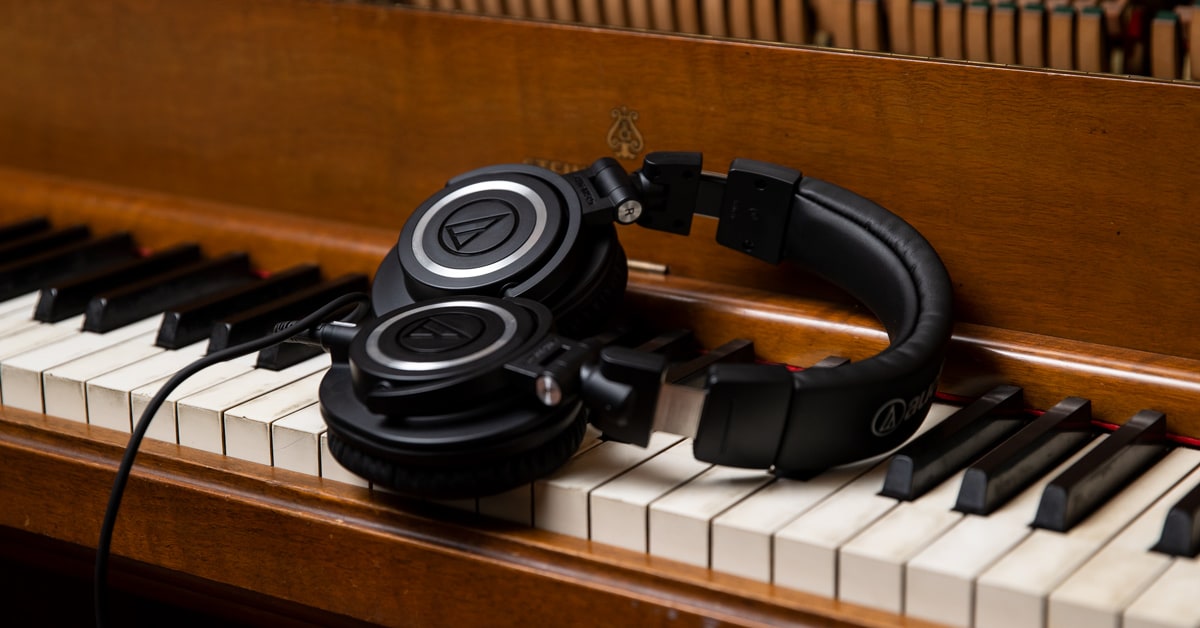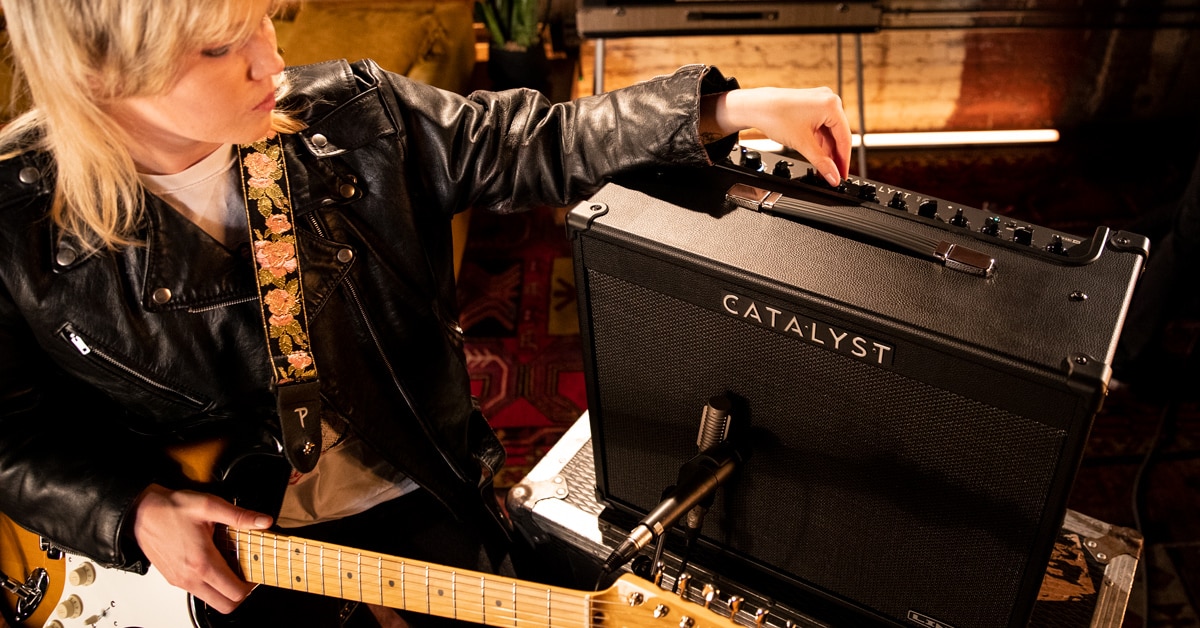The Line 6 Catalyst series has proven to hold some of the most popular and in-demand new amps on the scene. Based on Line 6 HX technology, but designed to look, feel and operate like a traditional non-digital amp, Catalyst delivers an incredible range of sonic flexibility, while remaining a totally plug-and-play experience for the musician. We sat down with Senior Product Manager Rick Gagliano, a long-time industry veteran and a serious guitarist in his own right, to talk about how Catalyst was born, and how it inspires players. Along the way, you’ll get a chance to see and hear guitarist Liv Slingerland walk through the amp models and show you some of what they can do.
At a high level, what is Catalyst? Obviously, it’s a guitar amp, but what was the underlying spirit behind it?
Rick Gagliano: We wanted to build a great-sounding amp that didn’t “feel” digital, while also having some unique Line 6 magic under the hood, so we looked at a couple of things. First, we had some feedback from players. I think players are always ready for a great-sounding solution, especially one that can work for the stage and the studio. We’re always trying to keep our fingers on the pulse of the market and keeping an eye on what was happening in both digital amplifiers and just amplifiers in general. There were definitely some changes taking place, and we thought players would respond to a traditional user interface, classic look and feel, and, most importantly, good sound quality.
The Catalyst family features our original amp design models, which were custom created by the team here at Line 6. It’s the same sound design team that brought you the Helix products. We also included some great effects and reverbs from our HX and Legacy sound libraries.
There’s a 60-watt 1x12, a 100-watt 1x12 and a 200-watt 2x12, with very similar features across all of them. The sound quality is really quite amazing.
You mentioned the unique amp voicings that were created specifically for Catalyst. Can you tell us a little bit about the process? How do you create amp voicings?
Yeah. That’s a great question. The sound design team here has been modeling some of the most popular amps around for a number of years. They’ve got the tools that allow them to do that down to component level. They’re all great players, and they’re all designers, with many of them having built some of their own tube amps. So, we said to them, “If you were to create your own amp designs, what would you do differently than what you’re already doing?”
Our goal was to create familiar tonal centers, but to do some things that are not possible in the physical realm. For example, if you run a tube amp with too high of a voltage, you can run into something commonly known as “red plating.” This occurs when the amp is drawing too much current, and it’ll overload and overheat. When that happens, that’s obviously on its way to failure. However, when that happens, there’s something unique that happens to the audio. Then we say, “Is that thing a desirable thing? Is there more compression? Is there more distortion?” Since we’re in the digital world we can capture that state and keep it there without any problems. So, we did experiments like that. We also tested adding multiple preamp stages. What if instead of three preamp tubes or five preamp tubes, we have 20 or 50 or 100? So, we kind of just let them loose to experiment. If you listen to the amp voicings on Catalyst, they’re in familiar territory, but there’s some extra digital magic happening.
It’s interesting you brought up the red plating, something that, to your point, is a sign of impending failure. So, it’s not that you’re necessarily creating new physics or anything like that, it’s just that you’re saying, “This doesn’t have to break,” so you can push that modeled red plating as hard and as long as you want, with no risk of component failure.
I think that’s a great way to sum it up. I mean, we haven’t quite broken the laws of physics yet, although the guys are always trying to do crazy things. But in a general sense, yeah, we’re thinking, “What are the states that might present a desirable result that ultimately result in either a failure or fire in a traditional tube amp? What are the things we could capture in the digital realm?”—provided that they were a pleasant audio experience, of course!
It’s almost like the digital equivalent of where you grab a modern fuzz pedal that has a bias control to emulate the performance of a dying battery.
Yeah—it’s kind of to the nth degree and, as I said, even down to component levels—diodes, triodes—if you can imagine that. We really let the sound design team just go a little crazy.
Can you tell us a little bit about the sound design process? What kind of voicing and testing environment are they working in?
First, we have the sound design team get something sonically that they’re onboard with, and we do a number of test stages. We tested in a number of setups. We listened on studio monitors. We built some makeshift cabinets. We tested on no fewer than a couple dozen speakers and cabinet sizes. The idea was to try to get market data as well as internal data. So, as we’re developing the amp model designs, there are hunches the sound design would have, guided by familiar baselines from other products.
One of the coolest things I thought we did was a blind sound test. We used a local studio and set up a number of competitive models and our own Catalyst models, set to the different amps, at their various voicings. We kept them covered and concealed, and we brought in dozens of players from all different styles and abilities, and had them compare and contrast what they liked—and maybe what they didn’t like—about some of the sounds. We used that feedback, along with all the internal testing, to end up informing and validating design decisions.
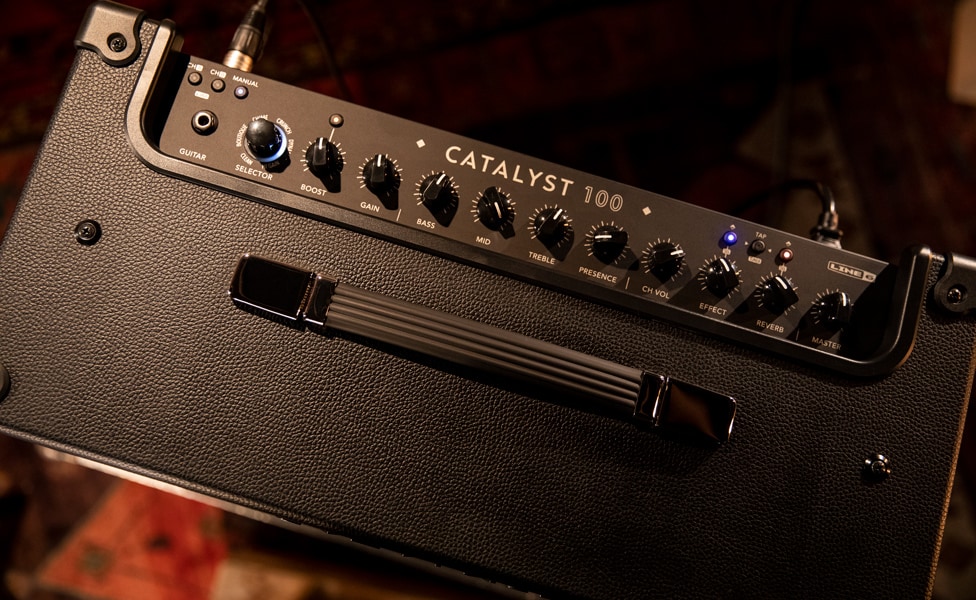
As you and your team were developing and refining Catalyst, what were the qualities you were looking for that made playing these feel like non-digital amps, rather than digital models?
That’s the million-dollar question, right? While we were going through the project, we had a virtual vision board, and we kept that there. We would keep coming back to, “It has to sound, and it has to feel, like a traditional amplifier.”
There was always a baseline expectation of what a good sound quality was going to be. Feel was something a little different—you kind of just get it when you play. So, it was important for us to capture that. I think, at least speaking for myself, it seems like players—whether they be people on forums or video comments—seem to be connecting to the fact that Catalyst responds the way a traditional amplifier would. If you hit it hard, it does the thing that a normal amp does. If you roll off the volume, it breathes and responds like a traditional amp, and I think people are catching on to that.
Another thing we wanted to do to make it “authentic,” was to have the look and feel of a traditional amp. So, if you notice, it’s a kind of simple, two-channel layout with familiar controls. We have some power under the hood, of course, along with an app that lets you further customize it, but we really wanted people to plug in and play. Throughout the testing process, we saw that people would bring up one of the sounds, start playing it and get lost in playing, not in scrolling through a million different amps or effects, and that was important for this type of product.
There’s a lot to be said for the immediacy of plugging into a vintage tweed amp or an AC30 or a Plexi. You don’t want to take yourself out of the moment, right?
Exactly. We wanted people to be inspired to play their guitar. Obviously, there’s nothing wrong with any of the products, including some of our own, that offer a wide range of possibilities, but this was really aimed at creating an environment where somebody’s going to feel comfortable just plugging in and playing. Of course, if they want to tweak it, or they want to make something customized, they can do that as well, using the app.
Digging into the amp a little further, can you give us a high-level overview of what each of these new amp designs sounds like? You mentioned they aren’t based on specific models, as such, but they are based in familiar territories.
We thought it was important to have, for lack of a better term, generic names so people could get a sense of what they might be hearing, rather than just like numbering the sounds or something like that.
So, let’s start with the Clean voicing, which we call Pristine if you open it in the editor. It’s a real sparkly, kind of spangly vibe. There’s no coloration of sound, even if you turn it all the way up. It was influenced by some revered solid-state amps, with some adjustments in the gain structure.
The Boutique amp, which is the second setting, is called Aristocrat. This was inspired by some of those unobtainable, boutique black-panel amps that many artists have used over the years. We incorporated some of those “impossible on a real amp” things, like the red plating example we discussed a little earlier.
The Chime model is based on a hot-rodded EL84-style amp, with additional grit in some of the higher gain settings, which is not normal for that type of a product.
The Crunch amp—we call that model Voltage—is British-inspired chunk and crunch, with some digital magic happening in the preamp section, especially if some of the boost function is engaged.
The Dynamic setting, which the Catalyst is called Kinetic, is my favorite of the settings. It’s a modded version of a previous Line 6 creation called The Cartographer, which is available in the HX family of products. It’s ultra-touch responsive, and, depending on how hard you dig in or how your volume knob is set, it really provides a wide range of tone, which is cool.
And then there’s the Hi-Gain setting, which we call Oblivion. I think the name says it all. It’s a super-tight modern high-gain sound, with some additional low-end bass boost we made sure didn’t get muddy. We worked really hard to make sure this one stays really nice and full, even at lower volumes.
You touched a little on the boost when describing one of the amp voices just now. The Boost function will behave differently from one amp to the next, right?
It’s not just a standard volume boost. It actually does different things, depending on which amp voice you select.
So, on the Clean, it basically adds an extra two gain stages with some gentle clipping in there. On the Boutique setting, it is a standard boost right before the amp, based on one of the boosts from our HX gain category. On the Chime amp, it adds a germanium transistor treble booster before the amp model. On the Crunch amp, it adds an extra gain stage in front of the preamp. On Dynamic, it does some really cool stuff where it adds both gain and EQ mods as you turn the knob. If you turn the boost knob, you’re more or less simulating some of the classic amp mods that have happened to some of those classic British amps over the years. So that one is doing some real special stuff.
You mentioned that’s going to change the EQ. Does the boost actually change the tone stack, or is it just changing the overall frequency response of your sound as you adjust the boost?
Really just as you adjust the boost. It doesn’t necessarily affect the tone stack as it exists. That’s a great question.
Okay, thanks for clarifying.
Finally, on Hi Gain, the boost just adds a classic overdrive, right before the amp voicing. That’s based on one of the overdrives that’s available in the HX library.
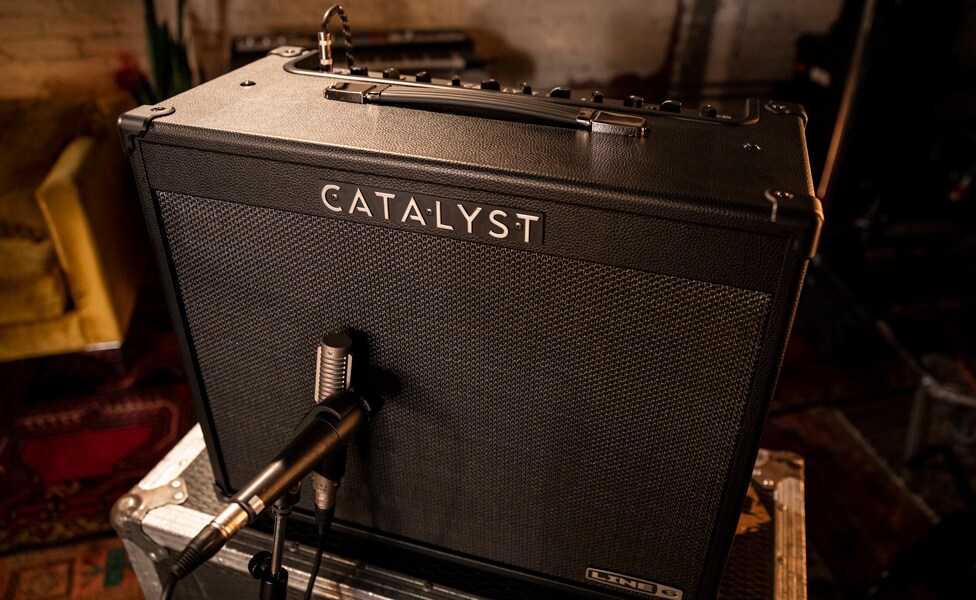
The Catalyst was primarily set up to run with two footswitchable channels, right?
Yeah, we wanted to keep this kind of simple. We set it up so that you could simply create your two base sounds—maybe a clean and a dirty—switch between them, and kind of rock out if that’s what you wanted to do. Another great option though, is within the editor app. You can change the function of the second footswitch, so it can also control reverb on/off, boost on/off, tap tempo or some combinations of those. Additionally, you’ve got six banks of those two channels that you can get at, either from the front panel or from an external MIDI controller.
So, let’s touch on the app. This is completely cross-platform, right? Mac, PC, iOS and Android?
When we designed the app, one of the things we wanted to make sure of was that it works on all the major platforms. Now, within the app you can, of course, access all those presets. You can create your own presets and save them directly to your amplifier, or offline on your smartphone, your tablet or your computer.
Are there any differences in functionalities from one platform to another?
We kept the functionality pretty standard across them. The only difference really is the layout for different size screens.
Can you give us an overview of what the effects section offers players? Do you have any favorites?
Unlike some of our other products we didn’t put every delay or every modulation that we have in our library in there. We custom curated it thinking about the player that was likely to use this amp and the types of sounds they’re likely to build. So, we included six each of delays, modulation, and pitch and filter effects, along with six reverbs. They’re all right out of either the HX library or our legacy effects libraries, like the M-series effects, for example. All of the effects can be set either in the pre or post position from the front panel or from the editor.
As far as favorites, I really like the Transistor Tape Delay, just because it sounds so accurate to what I used to play a million years ago in studios. I would actually use the old transistor tape delays, and they really captured the essence of that. I also like the Plastic Chorus. Out of the reverbs, the Hot Spring and the Plateau are really my favorite, and they’re, again, right out of the HX library.
If there are players who are already members of the Line 6 community—and there are tons of them out there—they will recognize many of the effects in Catalyst. We’ve got Simple Delay, Vintage Digital Delay, the Transistor Tape Delay, the Adriatic Delay, Duck Delay, and a Stagger Rhythm Delay, all directly out of our HX library.
On the modulation side, we’ve got the the Plastic Chorus, Harmonic Trem, the Script Mod Phaser, the Gray Flanger, Ubiquitous Vibe and the Rotary Drum Effect. Again, all directly out of HX.
On the pitch side, everything but the Octavia and the Simple Pitch are from our legacy library, so some of those go back all the way to the four-button stomp products, and in one case, I think the original kidney-shaped POD.
And then the reverbs, some of which I just mentioned, are Hot Springs, Hall Chamber and Plate, the Plateau that I mentioned, and then the Canyon Reverb. They’re all directly out of the HX library as well.
While we’re still on the topic of effects, I want to talk about both how it ties in with the app and what type of control does someone have from the amp versus connecting to the app?
There’s a good portion of the settings that are accessible from the amp itself, although it’s one of those things where you kind of have to read the manual to get to some of it, because there are some hidden features. If you connect the USB to the editor app, the additional things you’ll get are deeper amp settings. For example, we include things like the Hum, Bias and Bias X settings on the amp controls. You’ve got more control over the built-in noise gate, where you can simply turn it on or off from the front panel. You’ve got deep edit parameters for the effects, things like delay time, feedback, chorus, mix etc., whereas you’re kind of stuck with some of the settings on the front panel if you don’t jump into the editor there.
You know, the other cool thing about the editor is you can tweak any of those and then save them into the 12 preset slots on the amp or a separate file list on your computer, tablet or phone.
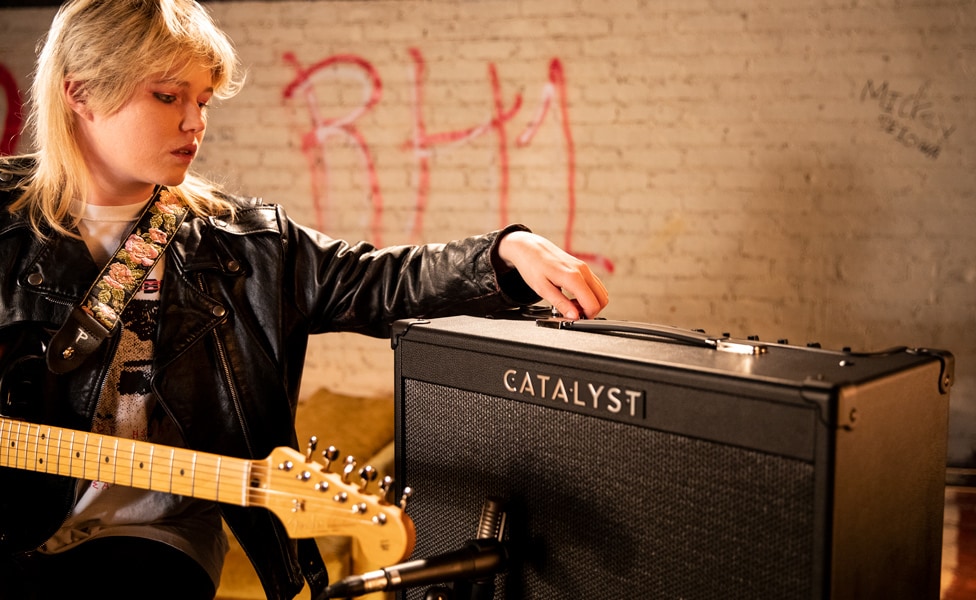
It sounds like it’s really set up nicely so that if you’ve got a gig coming up, you can plan your set and your sound beforehand. You just load up your settings and you’re good to go, right?
Yeah, that was the plan, and what we’ve learned since the release of Catalyst, is that a lot of people are seeing it as a great pedal platform. So, they’re using standalone effects pedals in combination with the effects that are onboard. Some people are using it with a four-cable connection method for an external modeler. And then another interesting feature that has happened is players using the the Power Amp in, which is an additional switch on our effects loop which basically bypasses the front panel on the amp and just goes to the power amp section. We’re finding that there are players that are plugging in their modeler or processors right into that, with the Power Amp switch in engage and using it as powered speaker.
It is worth nothing that this is not an FRFR solution, like our Powercab products are, but there does seem to be at least a section of players that are really kind of responding to this “amp in the room” approach here, based on how the Catalyst guitar speaker responds.
In addition to the master volume, there’s an output power control. Would you mind explaining how that works?
We’ve got four different settings. It’s an easy way to adjust the overall output power, and it’s not the same as just turning the master volume down. The four settings are full power, half power, half a watt or mute, which you might use for silent recording or using headphones.
What’s happening is that, at each of those settings, we’re doing some bass attenuation and some kind of Fletcher Munson Curve [Ed. note: aka equal loudness curve] there, which take into account the way the human ear hears frequencies differently at different loudness levels. We adjust for that in each of those settings.
You just touched on using the output power control for silent recording. Can you touch on the various recording setups someone might use with Catalyst?
Absolutely. The XLR-DI, the direct out, is great for just going right to a mixer, or a stage snake if you’re in a live situation. We’ve included three cab impulse responses as well as a number of different mics you can place for those direct outs, which are accessed through the editor. So, if you really like the way the amp sounds and feels on stage, but you want your front-of-house engineer to have it feel like it’s going through a 4x12 cab with a particular mic on it, you can do that in the settings.
With the USB feature though, it has a 4x4 audio interface. It lets you record right to your DAW from the amp, and it also allows for reamping within your DAW, which is great. It also lets you record a dry signal at the same time in case you want to go back and swap to a different amp sound or a different effects sound.
Earlier you briefly touched on using Catalyst with a MIDI controller. What level of MIDI control does Catalyst offer?
Well, there’s a pretty extensive MIDI menu for Catalyst. All this info, by the way, is found in our Pilot’s Guide manual. Most of the parameters, which include everything from amp voicings, effects level and tap tempo, to the DI out cab and mic select that we just talked about, are assignable to MIDI switches or continuous controllers as well.
A simple approach is to get a standard MIDI controller. You can set up your 12 presets the way you like them and use program changes to switch through them. But, of course, with all that additional capability, there’s a lot more players can do.
If you’re in a recording environment, you could automate MIDI messages to gradually change the performance or the response of the amp, whether you’re adjusting EQ or drive or the boost, while someone’s playing. So, you can play, automate it and then record that signal, right?
Absolutely. That’s a deep dive for sure. But, yeah, the MIDI capabilities are pretty strong. We were cognizant of how far it could go, looking at how deep we went on the Helix family, but we wanted to make it easy enough that it was accessible.
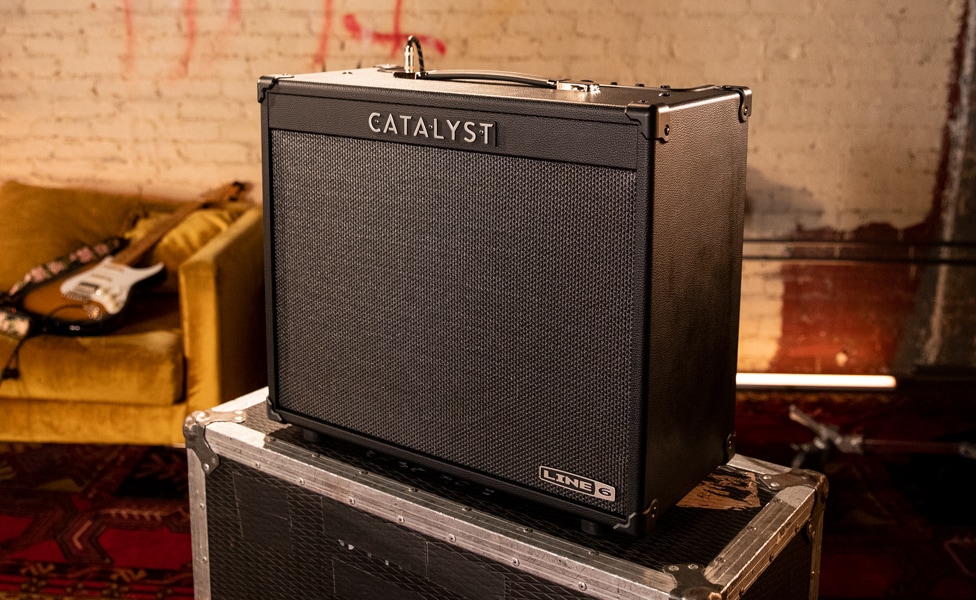
Did you have a specific player in mind as you were developing Catalyst? Weekend warrior? Gigging pro? Maybe someone graduating from a Spider?
You know, I think we designed this for a couple of different players. First and foremost, we kind of built it for a player that just wanted a great-sounding, easy-to-use amp for a home rehearsal. Obviously, features like the power control come in handy for that. We wanted it loud enough for stage use in a number of venues. As we touched on, it’s also great for home recording with the built-in audio interface.
What has been interesting to me, is to see that real tube amp enthusiasts on some of the forums and YouTube and elsewhere, are reveling in the realness of the Catalyst tone. So, I think it has really resonated with a lot of different players.
With Catalyst, it is really about best-in-class sound quality with a traditional UI. We included the editor for customization because we thought that a Line 6 customer would expect that for obvious reasons. And then we wanted to use the HX sound design technology which allows us to deliver best-in-class audio performance. The key here for Catalyst, was a great-sounding amp where you can dial in usable sound in seconds—really for almost any player. The other thing that I’ll mention is that most of the DSP in the Catalyst amps is being used to create those lush original amp design sounds.
As you think about someone walking into their local Guitar Center and plugging into a Catalyst amp, what are you hoping they’ll experience? Do you have any particular setting you might recommend?
I think for the first time that people plug in to a Catalyst, what we hope they’ll experience is that a really familiar, uncomplicated user interface will make it so they can get a great sound quickly. The advances that our sound design team has made in modeling over the years are really pretty amazing. It’s getting more and more difficult these days to distinguish a traditional amp from a great digital model. Since Catalyst uses our own original amp designs, with this wide range of great sounds, we hope that it inspires people to play more often.
Over the past 10 to 15 years, it feels like what people look for in a stage amp versus a studio amp isn’t actually that different anymore, especially when you look at an amp like the Catalyst. As you look to the future, how do you anticipate that impacting amp design?
Yeah, the worlds have kind of started to collide in interesting ways. I think it’s been fantastic for players because the offerings are so vast, and they offer so many great solutions.
I think over the next few years there’s going to be less of a desire to capture a specific kind of amp sound. What I mean is that the brand names and products that we’ve grown up listening to on records … for players of a certain generation, those are reference points, right? I think there’s going to be less of that, and just more of a desire for creating a great sound, no matter what the inspirations. I also think further experimentation to do some of the things that we discussed—the things that are kind of impossible in the real world—I think that that could really provide some overarching capabilities for new soundscapes and new sound design options. I think, hopefully, in the next few years what we’ll see is a gravitation toward great sound no matter what it’s from.
With complete reverence for all the great amps and effects that have come to guitar players over the years, but very few players that I know have never plugged in to an original design Hiwatt, for example, or have never plugged into a JTM45 and played at a club-level volume. So, I think that that’s one of the reasons. I think the reference points may change.
Another thing—even just in the last couple years, COVID really changed the way people experience music, right? There are TikTok videos and YouTube videos, and this whole generation of players where all of their playing is happening in the digital realm. I think that the tools that they have now are just so vast, and so broad—I think that alludes to that fact that, as long as it’s a means for an artist to get the creativity across, a good sound is a good sound.
As far as what the future holds, that’s a great question. If I were to get out my Magic 8 Ball, I think in 10 or 20 or 50 years down the road, I’m not sure. We still don’t have the flying cars I was promised when I was a kid. But I think the organic nature of guitar playing is always going to exist and continue to evolve and, you know, I just hope that Line 6 will continue to be a part of that growth.








